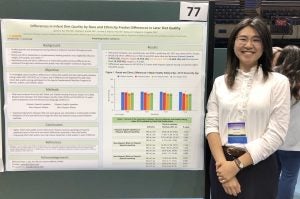Implementing innovative telehealth nutrition interventions
Telehealth is a way to provide health-related services, such as nutrition education or counseling, remotely through computers, smartphones, or tablets. This can allow more flexibility and convenience for participants. Dr. Au is partnering with Tufts University to evaluate various telehealth strategies in WIC. She is also collaborating with Dr. Leigh Ann Simmons to evaluate a mHealth dietary intervention for overweight and obese pregnant mothers. Dr. Au has experience leading randomized trials comparing online nutrition education to in-person education on dietary outcomes in WIC
Related publications
- Au LE, Whaley SE, Hecht CA, Tsai MM, Anderson CE, Chaney AM, Vital N, Martinez CE, Ritchie LD. California WIC participants’ and local agency directors’ experiences during the COVID-19 Pandemic: A qualitative examination. Journal of Academy of Nutrition and Dietetics. DOI: https://doi.org/10.1016/j.jand.2022.07.003. [PubMed link]
- Au LE, Whaley S, Gurzo K, Meza M, Ritchie LD. If you build it they will come: Satisfaction of WIC participants with online and traditional in-person nutrition education, Journal of Nutrition Education and Behavior, 2016; 48:336-342. [PubMed link]
- Au LE, Whaley S, Gurzo K, Rosen NJ, Meza M, Ritchie LD. Evaluation of online and in-person nutrition education related to salt knowledge and behaviors among WIC participants. Journal of the Academy of Nutrition and Dietetics, 2017; 117(9):1384-1395. [PubMed link]
- Au LE, Whaley S, Rosen NJ, Meza M, Ritchie LD. Online and in-person nutrition education improves breakfast knowledge, attitudes, and behaviors: a randomized trial of WIC participants. Journal of the Academy of Nutrition and Dietetics, 2016; 116(3):490-500. [PubMed link]

Creating novel dietary assessment methodologies
Conclusive evidence points to the fir
st 1,000 days – or the period from conception to 24 months – as critical for childhood obesity prevention. Healthy nutrition during the complementary feeding period, around 6-12 months of age, is critical for optimal growth and development. By 3-5 years of age, most children have established dietary habits that impact long-term weight and health. A better understanding of diet quality during the first year of life that contributes to healthy weight maintenance can inform intervention strategies to lower obesity and other chronic diseases. Dr. Au’s research examines how diet quality during the critical complementary feeding period during infancy is associated with risk for obesity in childhood.
Related publications

- Au LE, Gurzo K, Paolicelli C, Whaley SE, Weinfield NS, Ritchie LD. Diet Quality of U.S. Infants 7-24 Months Old in the
WIC Infant and Toddler Feeding Practices Study-2. Journal of Nutrition, 2018; 148(11):1786-1793. [PubMed Link] - Au LE, Paolicelli C, Gurzo K, Ritchie LD, Weinfield NS, Plank KR, Whaley SE. Contribution of WIC foods to the overall diet of 13 and 24 month toddlers in the WIC Infant and Toddler Feeding Practices Study-2. Journal of Academy of Nutrition and Dietetics, 2019; 119(3):435-448. [PubMed Link]
- Tsai M, Frongillo EA, Ritchie LD, Woodward-Lopez G, Au LE. Factor analysis reduced complex measures of nutrition environments in U.S. elementary and middle schools into cohesive dimensions in the Healthy Communities Study. Journal of Nutrition, 2021; 151(5): 1286-1293. [PubMed Link]
- Au LE, Arnold CD, Ritchie LD, Frongillo EA. The Infant Diet Quality Index Predicts Dietary and Adiposity Outcomes in US Children 2 to 4 years old. Journal of Nutrition, 2023; 153(3):741-748. [PubMed Link]Infant Diet Quality Index (IDQI) statistical code available here

Improving dietary intake in federal nutrition assistance programs
Dr. Au’s research involves understanding how to promote healthier eating and prevent obesity through the Special Supplemental Nutrition Program for Women, Infants, and Children and the National School Lunch Program. Dr. Au’s overall goal is to provide evidence-based research to support strong nutrition policies for low-income populations
School Nutrition-Related Publications
- Chaney AM, Ritchie LD, Whaley SE, Tsai MM, Randel-Schreiber HR, Yepez CE, Sabatier S, Young A, Meza M, Au LE. Racial and Ethnic Comparisons in Satisfaction with Services Provided by the Special Supplemental Nutrition Program for Women, Infants, and Children in California. Nutrients, 2023; 15(2):447. [PubMed link]
- Martinelli S, Acciai F, Au LE, Yedidia MJ, Ohri-Vachaspati P. Parental perceptions of the nutritional quality of school meals and student meal participation: Before and after the Healthy Hunger-Free Kids Act. Journal of Nutrition Education and Behavior, 2020; 52(11):1018-1025. [PubMed link]
- Au LE, Ritchie LD, Gurzo K, Nhan LA, Woodward-Lopez G, Kao J, Guenther PM, Tsai M, Gosliner W. Post-Healthy, Hunger-Free Kids Act adherence to select school nutrition standards by region and poverty level: The Healthy Communities Study. Journal of Nutrition Education and Behavior, 2020; 52(3):249-258. [PubMed link]
- Tsai M, Ritchie LD, Ohri-Vachaspati P, Au LE. Student perception of healthfulness, school lunch healthfulness and participation in school lunch: The Healthy Communities Study. Journal of Nutrition Education and Behavior, 2019; 51(5):623-628. [PubMed link]
- Au LE, Crawford PB, Woodward-Lopez G, Gurzo K, Kao J, Webb KL, Ritchie LD. School wellness committees and policy implementation are associated with lower body mass index z-scores and improved dietary intakes in U.S. schoolchildren: The Healthy Communities Study. Journal of School Health, 2018; 88(9):627-635. [PubMed link]
- Au LE, Gurzo K, Gosliner W, Webb KL, Crawford PB, Ritchie LD. Eating school meals daily is associated with healthier dietary intakes: The Healthy Communities Study. Journal of Academy of Nutrition and Dietetics, 2018; 118(8):1474-1481. [PubMed link]
- Au LE, Rosen NJ, Fenton K, Hecht K, Ritchie LD. Eating school lunch is associated with higher diet quality among elementary school students, Journal of the Academy of Nutrition and Dietetics, 2016; 116(11):1817-1824. [PubMed link]
- Ritchie LD, Rosen NJ, Fenton K, Au LE, Goldstein LH, Shimada T. School breakfast policy is associated with dietary intake of fourth and fifth grade students. Journal of the Academy of Nutrition and Dietetics, 2016; 116(3):449-457. [PubMed link]

WIC Related Publications
- Au LE, Ritchie LD, Tsai M, Randel-Schreiber HR, Martinez C, Gradziel PH, Sabatier SM, Whaley SE. Alignment of California WIC participant preferences with proposed WIC food package recommendations. Journal of Nutrition Education and Behavior, 2021; 53(1):60-66. [PubMed link]
- Weinfield NS, Borger C, Au LE, Whaley SE, Berman D, Ritchie LD. Longer participation in the Special Supplemental Nutrition Program for Women, Infants, and Children (WIC) is associated with better diet quality in 24-month old children. Journal of the Academy of Nutrition and Dietetics, 2020; 120(6):963-971 [PubMed link]

- Whaley S, Whaley M, Au LE, Gurzo K, Ritchie LD. Breastfeeding is associated with higher retention on WIC after age one. Journal of Nutrition Education and Behavior, 2017; 49(10):810-816.e1 [PubMed link]
Examining the relationship between food insecurity, obesity, and other chronic diseases
Dr. Au examines dietary intake, including food insecurity, on obesity and cardiometabolic outcomes in racially and ethnically diverse populations. This body of work focused on understanding disparities in childhood obesity or related outcomes
Related Publications
- Zuercher MD, Harvey DJ, Au LE, Shadyab AH, Nassir R, Robbins J, Seldin MF, Garcia L. Genetic admixture and cardiovascular disease risk in postmenopausal Hispanic women. International Journal of Cardiology, 2022; 367: 99-104. [PubMed link]
- Navarro S, Tsai M, Ritchie LD, Frongillo EA, Laraia BA, Pate RR, Au LE. Household food insecurity and children’s physical activity and sedentary behavior: The Healthy Communities Study. Public Health Nutrition, 2022; 25(2): 381-388. [PubMed link]
- Moffat L, Ritchie LD, Gosliner W, Plank K, Au LE. Perceived produce availability and child fruit and vegetable intake: The Healthy Communities Study. Nutrients, 2021; 13(11):3681. [PubMed link]
- Tan ML, Laraia B, Madsen KA, Au LE, Frongillo EA, Ritchie LD. Child food insecurity is associated with energy intake among fourth and fifth grade girls. Journal of Academy of Nutrition and Dietetics, 2019; 119(10):1722-1731 [PubMed link]
- Au LE, Zhu SM, Nhan LA, Plank KR, Frongillo EA, Laraia BA, Gurzo K, Ritchie LD. Household food insecurity is positively associated with higher adiposity among U.S. schoolchildren ages 10-15 years: The Healthy Communities Study. Journal of Nutrition, 2019; 149(9):1642-1650. [PubMed link]
For a full list of publications by Dr. Au, please click here





